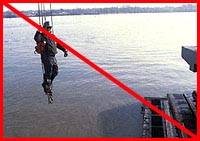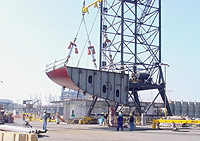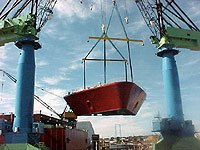Shipyard Employment eTool
Material-handling equipment (such as cranes and derricks) and rigging gear (slings, shackles, and hooks) must be used correctly and safely to prevent accidents and serious injuries.

Potential Hazard
Worker injuries can be caused by falling loads due to rope, chain, or sling failure during the lifting of items due to overloading, worn or defective equipment or improper use of connection of the lifting components.
Requirements and Example Solutions
Attaching and moving loads
- Loads must be safely rigged before being hoisted. [29 CFR 1915.116(b)]
- Metal plate must be handled on and off hulls by means of: [29 CFR 1915.116(c)]
- Shackles whenever possible
- Welded clips or pads of ample size
- Alligator tongs
- Grab clamps or screw clamps
- Tag lines must be provided on loads likely to swing or to need guidance. [29 CFR 1915.116(d)]
- When eye-bolts are used, spreaders may be required to reduce the side pull on the eye-bolt. [29 CFR 1915.116(e)]
-
Skips must be rigged with a minimum of three-legged bridle. When open-end skips are used, means must be taken to prevent the contents from falling. [29 CFR 1915.116(g)]

- Loads (tools, equipment or other materials) must not be swung or be suspended over the heads of workers. [29 CFR 1915.116(j) and 29 CFR 1915.74(a)(12)]
- When the hoist operator can not see the load, a person to signal the operator is required. [29 CFR 1915.116(l) and 29 CFR 1915.117(b)]
- Pallets must be able to support the loads. [29 CFR 1915.116(m)]
- Sufficient advance warning must be given before loads or lifting gear are moved. [29 CFR 1915.116(p)]
-
When ship's gear is used to hoist, a competent person (not the Shipyard Competent Person), must determine that the gear is properly rigged. [29 CFR 1915.117(a)]

- Shock loading is prohibited. [29 CFR 1910.184(c)(11)]

Working with slings
- Slings must be padded or protected from sharp edges. [29 CFR 1915.116(f)]
- Loose ends of idle legs of slings in use must be hung on the hook. [29 CFR 1915.116(h)]
- Slings that are damaged or defective must not be used. [29 CFR 1910.184(c)(1)]
- Slings must not be shortened with knots, bolts, or other makeshift devices. [29 CFR 1910.184(c)(2)]
- Sling legs must not be kinked. [29 CFR 1910.184(c)(3)]
- Slings must be securely attached to the load. [29 CFR 1910.184(c)(6)]
- Suspended loads must be kept clear of all obstructions. [29 CFR 1910.184(c)(8)]

Worker protection
- Workers must not ride the hook or the load. [29 CFR 1915.116(i)]
- Hatches, through which materials are moved, must be completely open and hatch covers must be secured. [29 CFR 1915.116(n)]
- Hatch covers must not be opened or closed while workers are below the hatch. [29 CFR 1915.116(o)]
- Workers must not be in between a swinging load and a fixed object. [29 CFR 1915.116(q)]
- Workers must keep clear of suspended loads and of loads about to be lifted. [29 CFR 1910.184(c)(9)]
- Hands or fingers must not be placed between the sling and its load while the sling is being tightened around the load. [29 CFR 1910.184(c)(10)]

Using crawler, locomotive, and truck cranes
- The hoist rope shall not be wrapped around the load. [29 CFR 1910.180(h)(2)(i)]
- The load shall be attached to the hook by means of slings or other approved devices. [29 CFR 1910.180(h)(2)(ii)]
- Side loading of booms shall be limited to freely suspended loads. [29 CFR 1910.180(h)(3)(iv)]
-
Cranes must not be used for dragging loads sideways. [29 CFR 1910.180(h)(3)(iv)]

- Neither the load nor the boom shall be lowered below the point where less than two full wraps of rope remain on their respective drums. [29 CFR 1910.180(h)(3)(x)]
- When two or more cranes are used to lift one load, one designated person shall be responsible for the operation. He shall be required to analyze the operation and instruct all personnel involved in the proper positioning, rigging of the load, and the movements to be made. [29 CFR 1910.180(h)(3)(xii)]
-
Operators must not be permitted to leave their positions at the controls while the load is suspended. [29 CFR 1910.180(h)(4)(i)]


